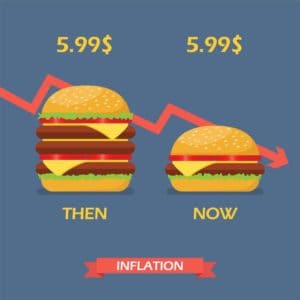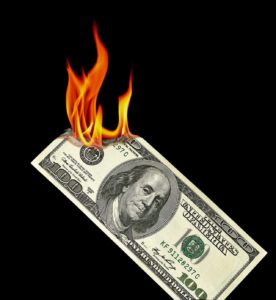
Turn on any business news channel and before long, three pundits will appear to debate the future direction of the economy.
Oftentimes the discussion is centered on whether we will have inflation, deflation, or even worse, stagflation like in the 1970s.
Each will make the case with economist jargon and use data to back up their conviction, but after just a few minutes, his or her brain will likely go to sleep mode.
This would be a mistake since where prices go will have an impact on your pocketbook and portfolio, and you need to protect both. There is a compelling reason for gold, which is staring us right in the face.
More on this in a moment but first let’s address the inflation issue...
My college textbook defines inflation as “a persistent increase in the level of consumer prices or a persistent decline in the purchasing power of money, caused by an increase in available currency and credit beyond the proportion of available goods and services.”

Inflation is an upward movement in the average level of prices. Its opposite is deflation, a downward movement in the average level of prices.
Inflation is the expansion of money and credit. Deflation is the contraction of money and credit. The boundary between inflation and deflation is price stability and the most common situation is a low level of inflation in the 1% to 3% range.
There you have it, the jaws of high inflation can squeeze your purchasing power and nest egg while the claws of deflation pull both an economy’s growth rate and stock markets down to earth.
In a healthy economy, there will always be a modest inflation since it serves as a lubricant to the wheels of commerce and keeps economic momentum moving forward.
Price stability leads to all actors in an economy being able to make sound economic decisions and fosters a virtuous cycle of growth and progress.
But high inflation discourages investment and savings – the fuel for growth and productivity.
In my view, deflation, or falling prices, is much more dangerous to an economy as well as more difficult to combat than rising inflation
Let’s just look at the probabilities of each occurring, how they will affect your financial well being and, most importantly, what you can do to hedge your bets and protect your portfolio.
It is important to note that price levels reflect, to a large degree, psychological leanings.
For example, if most people expect prices to rise sharply, producers will raise prices to protect themselves, workers will negotiate higher pay increases and the cycle continues and accelerates.
The same is true with deflation, if consumers believe that overall prices will fall, they will delay large purchases, companies will reduce costs to maintain margins, and economic growth will suffer.
Most financial pundits dwell only on the likelihood and risks of high inflation. I will try to be evenhanded and look evenly at the twin risks of deflation and inflation.
I’ll also offer you some investment ideas and strategies to cope with either scenario.
Before getting into your investments, let’s briefly look at how rising and falling price levels impact your pocketbook. Normally, rising inflation is coupled with a rising cost of money better known as interest rates.

These higher interest rates and the decline in your real spending power are like a one-two punch to your standard of living.
During high inflationary periods, the American economy is not as productive since borrowing, capital spending and productivity decline.
In an economy where inflation is rising quickly, interest rates rarely keep up, causing savers' hard-earned dollars to lose some buying power. Retirees are especially hard hit since a high inflation rate often means wage increases, but that won't benefit those who are retired.
Homeowners with variable mortgage rates and people with credit card balances see their borrowing costs climb periodically along with the broader inflation in the economy, leading to larger payments and weaker cash flows.
The real estate and construction business is particularly hard hit since high inflation leads to sharply rising home prices, high interest rates for mortgages and a relentless slide in the value of any money people have put away for a down payments.
Stagflation is the awful combination of lack of growth (stagnation) and persistent, substantial increase in prices (inflation). Remember the 1970s or still trying to forget?

Although the 1970s (during the Nixon, Ford, and Carter administrations), the Fed would stumble between stimulating the economy, trying to head off a recession — and then restraining the economy, trying to keep inflation from spinning out of control.
In the end, Nixon tried to spend his way out of it (not an option now) before Carter & Volcker finally crushed inflation by sharply increasing interest rates to cause a recession — thereby wringing inflationary expectations out of the economy like a wet rag.
I put the probability of America following the deflation or stagflation model at about 20%.
Provided that you get in early, a great place to be during a deflationary environment is in long-term bonds. The worst place is probably in the stock market.
Avoid most financial companies, especially mortgage oriented lenders that see collateral coverage plummet as housing prices fall and borrowers drop a notch or two in credit quality.
Cash is king and stocks get killed during deflationary times though there can be periodic and powerful rallies such as those that occurred during the 1930s.
The strongest case for a coming period of high inflation is not the Fed pumping enormous amounts of liquidity into our economy, but rather that inflation is perhaps the only way out of America’s incredible debt problem.
We now face $1 trillion+ annual budget deficits as far as the eye can see. And high inflation is the government’s best strategy to reduce the impact of high debt.
Michael Lewis writes in The Atlantic how in 1979, for example, the government ran a deficit of more than $40 billion — equivalent to about $118 billion in today’s money.
The national debt stood at about $830 billion as of 1980.
But because of 13.3% inflation, that $830 billion was worth what only $732 billion would have been worth at the beginning of the year.
So, in effect, the government ran up $40 billion in new debts but inflated away almost $100 billion and ended up with a national debt smaller in real terms than what it started with.
Now, the US national debt is over $22 trillion ($700,000 for each American) with $1.2 trillion budget deficits forecast for the next five years.
This is why I think the probability of a high inflationary environment going forward is about 80%.
In short, you should be concerned about inflation and your investments.
What should be your investment strategy if you expect inflation to not just go up a notch but get entirely out of control?
Just the word "inflation" strikes fear into the hearts of many Americans worried about a stagnating economy, rising prices, a falling dollar and an income that just can't keep up with the cost of living.
But while a high inflation rate hurts many Americans financially, it also presents opportunities for smart investors.
Stock investors get some protection from inflation because the same factors that raise the price of goods also raise the values of companies. But coping with the fear of high inflation is not easy because of uncertainty – the goal posts and the rules both keep moving.
While some companies can react to inflation by raising their prices, others who compete in a global market may find it difficult to stay competitive with foreign producers who don’t have to raise prices due to inflation.
More importantly, inflation robs investors by raising prices with no corresponding increase in value.
Adding some gold to your portfolio and nest egg is a great way to hedge this risk and protect your purchasing power.

Inflation and the US Dollar
There is also a high probability that higher inflation will lead to a decline in the value of the US Dollar.
Increasing global uncertainty and risk
Investors may wish to avoid it but there are a rising number of risks and unexpected shocks known as “black swans” that could turn your portfolio and finances upside down.
Here are just a few of them:
For all these reasons, gold is an excellent hedge on uncertainty and where investors worldwide go for some stability and safety.
Now lets get to the many ways to invest in gold.
Gold coins and gold bullion are perhaps the most obvious. This strategy avoids mining and market risk and is also both liquid and tradable.
The SPDR Gold Shares (NYSEArca:GLD) exchange-traded fund is also a good play on the price of gold and seeks to replicate the performance of the price of gold bullion on a one-to-ten ratio. The shares trade on the NYSE and may be bought and sold like any other securities.
If you feel more venturesome, the Market Vectors Junior Gold Miners ETF (NYSEArca:GDXJ) offers a more indirect exposure to gold through ownership in a portfolio of small and medium sized gold miner equities that generate at least 50% of their revenues from gold and/or silver mining.
Keep in mind that these smaller mining companies can be volatile. Recently, GDXJ has outperformed its large cap rivals and just this month passed $1 billion in assets.
You could also invest directly into a few high quality gold stocks.
Barrick Gold (NYSE:GOLD) has recently merged with Randgold Resources and is working with Newmont Mining (NYSE:NEM) in Nevada through a joint venture. Barrick Gold earlier made a takeover bid for Newmont so these two giants will both compete and cooperate on a grand scale.
Finally, if you wish a broader play on real assets that includes gold, take a look at the Van Eck Market Vectors Hard Assets ETF (NYSEArca:HAP) which weights each sector based on its share of world consumption with energy at 41%, agriculture at 31%, base metals at 13%, precious metals at 7%, forest products at 4%, and alternative energy at 4%. 87% of the companies in this basket are large cap.
I hope this discussion of inflation and deflation, debt, currency, and geopolitical competition has been helpful and should underscore any level of uncertainty in today’s markets.
One thing should be clear - no one knows precisely how future events will unfold and leaning against the winds of conventional wisdom is oftentimes a smart strategy.
Now is the time to consider adding some gold to your investment strategy since it serves as an effective hedge and shock absorber in times of uncertainty.

Carl Delfeld, Contributor
for Investors News Service
P.S. To discover more opportunities in the hottest sectors in North America, sign up now to the Financial News Now newsletter to get the latest updates and investment ideas directly in your inbox!
DISCLAIMER: Investing in any securities is highly speculative. Please be sure to always do your own due diligence before making any investment decisions. Read our full disclaimer here.
[1] Guide to Investing in Gold & Silver, by Michael Maloney
[2] The Black Swan: The Impact of the Highly Improbable by Nassim Nicholas Taleb
[3] Inflation & Deflation, Their Causes and Effects by Kimberly Amadeo, The Balance, November 9, 2018